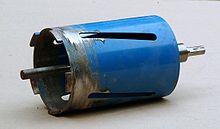- Hole saw
-
Not to be confused with Core drill.
A hole saw (also styled holesaw), also known as a hole cutter,[1] is a circular saw designed to cut through relatively thin workpieces. It is used in a drill.
Contents
Construction
The saw consists of a metal cylinder, usually steel, mounted on an arbor. The cutting edge either has saw teeth formed in it or industrial diamonds embedded in it. The arbor can carry a drill bit to bore a centering hole. After the first few millimeters of cut, the centering mechanism may no longer be needed, although it will help the bit to bore without wandering in a deep hole. The sloping slots in the cylinder wall help carry the dust out. The kerf of the cut is designed to be slightly larger than the diameter of the rest of the hole saw so that it does not get jammed in the hole.
Holes saws for use with portable drills are commonly available in diameters from 6 to 130 mm (0.24 to 5.1 in). The only limit on length of the cylinder, and thus depth of the hole, is the need to remove the bit from the hole to clear dust. A 300 mm (12 in) cylinder length is not uncommon, although shorter bits are usual. By breaking the core off from time to time and using a shank extension, a diamond core drill can drill to depths many times its length.
Saw teeth are used for most materials, such as wood, plastic, soft plaster, and metal. Diamond hole saws are used to bore holes in brick, concrete, glass, and stone.
Types
Adjustable
An adjustable hole saw consists of a number of thin metal saw blade-like strips, and a flat disc with a large number of grooves in one side and a shank on the other. By snapping the blades into different grooves on the disc, a hole saw of a wide variety of sizes can be constructed.
Circle cutter
Another type of adjustable hole saw, also called a circle cutter, is formed by having one, two, or three adjustable teeth on a platform with a pilot bit. To cut out a hole of any size, the teeth need only be adjusted to the proper position. This type is available in sizes up to a foot and larger, and can be used to accurately cut large circles.
Advantages and disadvantages
The main advantage over conventional drill bits is the hole saw's efficiency, because very little of the total material being removed is actually cut, which ultimately reduces the overall power requirement. Another advantage over drill bits is the wider size capability.
Some disadvantages include:
- The portable drill used must be capable of producing considerable torque at low speed
- They tend to bind if choked with dust, or if allowed to wander away from the central axis of the planned hole
- The kick-back from a powerful drill may be severe under some conditions, and long side-handles should be used, preferably with two operators for very large holes.
Wet or dry drilling
Diamond hole saws are also called diamond core drill bits. Laser welded diamond core drill bits can be used in wet and dry drilling, but not all materials to be drilled are suitable for dry drilling. Very hard materials like reinforced concrete normally should be drilled with water, otherwise the excessive heat generated during the drilling process may cause the diamonds on the core bit to become blunt, and then lead to poor drilling performance.[2]
The bond materials and the diamonds used on the laser welded diamond core drill bits usually are specially adjusted to fit the wet and dry drillings respectively. This can make the core bits perform better in drilling speed and/or lifespan.
References
- ^ Degarmo, E. Paul; Black, J T.; Kohser, Ronald A. (2003), Materials and Processes in Manufacturing (9th ed.), Wiley, p. 593, ISBN 0-471-65653-4.
- ^ Wet or Dry Diamond Core Drill Bits
Categories:- Hole making
- Metalworking cutting tools
- Saws
Wikimedia Foundation. 2010.




